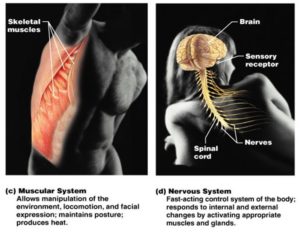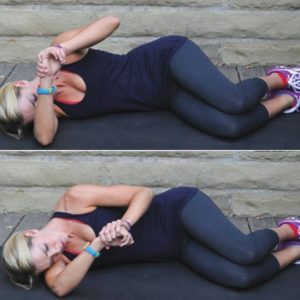So why stretch? What’s the purpose? Listed below are just a few of the major benefits that stretching and increasing flexibility provide:
1. Prevent injury and relieve pain. By stretching you increase your full range of motion. This takes and pressure off of and away from your joints, doing this allows a steady flow of movement during exercises. This results in helping to prevent injury and any pain that can be incurred with any lifestyle.
2. Circulation improvement. When you stretch you improve the circulation and increase blood flow to the muscles. This helps by removing waste byproducts in muscle tissue allowing your body to recover faster.
3. It is a great way to relieve stress. When you become anxious or worried and even run down and fatigued, it will place strain on your body. By performing stretches you allow the tension to unwind and relieve any stress felt in the body.
Understanding muscle tissue and nervous system control:
When you perform a stretch, the muscle fibres and tendons elongate.
Constantly stretching will not create a sustained lengthening of the muscles or fibres. This is because the muscle tissue attaches at fixed points in the bone, meaning it is not possible for the entire muscle complex to become permanently longer. Also it is not beneficial to allow the muscle to become permanently stretched out, as this decreases in elasticity.
I guess you’re wondering, ”if muscle fibre doesn’t get longer then how does stretching increase people’s flexibility?”
This is because of the nervous system, nerve endings are dispersed throughout the muscle and tendon. If a stretch doesn’t feel comfortable for the muscle, the nerves will register pain and create resistance.
But by repeating poses and stretches, you are retraining the nervous system to allow the movement at deeper levels of a stretch, also known as stretch tolerance.
After a while you will notice passive stretches may not be the most effective way of increasing flexibility. Trying proprioceptive neuromuscular facilitation (PNF), where you extend your muscles and then try to contract them from a lengthened position, could be a great way to control your nervous system and gain better momentum.
Taking all what has been mentioned above, why not try this 5-minute cool-down, your muscles will already be warmed up from training and you can get a feel for new movements.
Hold each stretch for 30 seconds, repeat all five stretches 2-3 times.
Downward Dog:
Benefits:
- Improves flexibility in calves, hamstrings and shoulders.
- Relieves pain in the low back
- Elongates cervical spine, which relieves tension in the body and head.
How to do it:
- Come onto your hands and knees with hands directly below your shoulders and knees directly below your hips.
- Spread your fingers wide and tuck your toes under.
- Inhale and lift your knees off the floor, pressing your hips up toward the ceiling.
- Draw your heels down to the floor or keep a slight bend in your knees.
- Press your hands firmly into the mat and draw your shoulder blades down.
- Keep the head between the arms (don’t let it hang).
- Take deep breaths the entire time.
Low Lunge:
Benefits:
- Improves flexibility in the hips and quadriceps.
- Releases the psoas, which is part of a group of muscles called the hip flexors.
How to do it:
- Come onto both knees and step your right foot forward.
- Make sure to keep your right knee over your heel and your left knee directly under your hip.
- Reach your left hand up toward the ceiling.
- Make sure to keep both hips facing forward and glutes engaged.
- Take deep breaths the entire time.
Lying Piriformis Stretch:
Benefits:
- Improves flexibility in the hips and glutes.
- Helps keep hip and knee joints properly aligned during activity and helps prevent sudden twisting.
- Allows for easy external rotation of the hips.
How to do it:
- Lie on your back, bend both knees, and bring your left ankle over your right thigh.
- Lift your right foot off the ground, bringing your leg up to a 90-degree angle.
- Loop your hands in between your legs and slowly draw your right knee in toward your chest.
- Keep your head and neck relaxed on the ground.
- Take deep breaths the entire time.
Lying Spinal Twist:
Benefits:
- Lengthens and realigns the spine.
- Increases flexibility in the hips and low back.
- Stimulates the digestive system.
How to do it:
- Lie on your back and bring both knees in toward your chest.
- Bring your hands out to your sides and draw your knees up and over to your left side.
- Keeping your shoulder blades on the ground, rest your knees on top of one another.
- Take deep breaths the entire time.
- When changing sides (after holding for 30 seconds), make sure to use your core muscles to bring your legs back to centre.
Posterior Capsular Stretch:
Benefits:
- Reduce the risk of shoulder injury by improving flexibility in the rotator cuff and posterior capsule.
- Improve range of motion in the shoulder.
How to do it:
- Lie on your right side with knees bent.
- Bring your right arm to a 90-degree position out from your body.
- Use your top arm to slowly draw your right hand toward the floor.
- Make sure to apply a small amount of pressure to the arm, do not force range of motion.
- It’s common to roll backward onto the shoulder blade, so make sure you stay directly on the shoulder.
- Take deep breaths the entire time.
- Repeat on the other side.









Post your comment